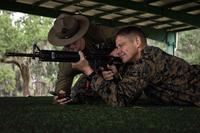The idea, at least at first, was to make the U.S. nuclear arsenal more stable, while reducing maintenance costs. Now, it looks like a new Energy Department initiative is going to be used to build a whole new class of nukes, pumping up the American stockpile. The Washington Post reports that by November, the Department of Energys National Nuclear Security Administration "plans to select the design of a new generation of nuclear warheads that would be more dependable and possibly able to be disarmed in the event they fell into terrorist hands."
The Washington Post reports that by November, the Department of Energys National Nuclear Security Administration "plans to select the design of a new generation of nuclear warheads that would be more dependable and possibly able to be disarmed in the event they fell into terrorist hands."
Nearly 16 years after the last new nuclear weapon was assembled at the Pantex Plant and 14 years after the last full-scale underground nuclear weapons test at the Nevada Test Site, Los Alamos and Lawrence Livermore national laboratories are competing again to design the next generation of warheads "which will be larger and more stable than the existing ones but slightly less powerful."
Intriguingly, these new weapons may incorporate new "use control" technology rendering them totally unusable in the event of theft, according to senior NNSA officials. How this would improve upon the already highly secure electronic locks -- known as Permissive Action Links or PALs -- now safeguarding all deployed warheads, was not explained.
This effort is part of the Reliable Replacement Warhead program, which was initially created in late 2004 by Rep. David Hobson (R-OH), chairman of the House Energy and Water Development appropriations subcommittee, as an effort to curtail more controversial and, in his view, unnecessary weapons programs like the now-canceled Robust Nuclear Earth Penetrator -- a nuclear bunker-buster. The original legislative justification for the program was simply to "improve the reliability, longevity, and certifiability of existing weapons and their components."
But the RRW has itself now become controversial, as officials discuss using it to create entirely new weapons and capabilities, eventually replacing every weapon in the stockpile. The effort has even become the linchpin of an ambitious and expensive 25-year plan to overhaul the nuclear weapons production complex, and with it the nuclear arsenal.
"We should not fail to take advantage of this opportunity," NNSA director Linton Brooks told the nation's nuclear lab chiefs in 2004. "We are now free to explore a range of technical options that could strengthen our ability to deter or respond to new or emerging threats without any concern that some ideas could inadvertently violate a vague and arbitrary limitation. I expect your design teams to engage fully."
I described the genesis and raised some serious questions about the program in an article in the Bulletin of the Atomic Scientists last year. And the current issue of Arms Control Today features a piece by Robert Nelson, a physicist and senior scientist at the Union of Concerned Scientists, which effectively demolishes the three myths underlying the RRW: That stockpile reliability is degrading; that warheads can be re-designed without compromising safety or requiring nuclear testing; and that the RRW will reduce pressure to resume nuclear testing in the future.
Other experts weigh in here on whether plutonium aging poses a serious threat to the long-term viability of the arsenal. Hobson has taken note. At a hearing before his subcommittee in late March, he warned NNSA officials not to overreach. "This is not an opportunity to run off and develop a whole bunch of new capabilities and new weapons," he said. "This is a way to redo the weapon capability that we have and maybe make them more reliable, make them better mission capable." Later this year, we may find out whether the NNSA and the weapons laboratories were listening.
-- Stephen I. Schwartz
Backdoor to New Nukes
© Copyright 2024 Military.com. All rights reserved. This article may not be republished, rebroadcast, rewritten or otherwise distributed without written permission. To reprint or license this article or any content from Military.com, please submit your request here.







